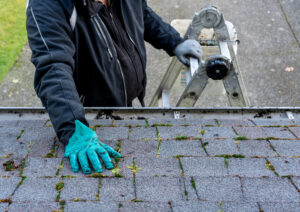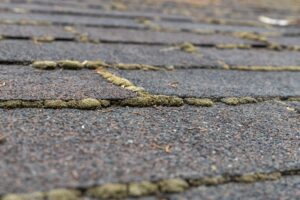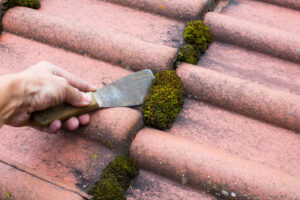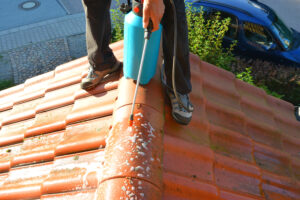Does Moss Damage a Roof?

Moss growing on roofs is a common sight, especially in damp, shady areas. Some homeowners see roof moss as a charming addition that gives their home a quaint, countryside look. But not everyone finds roof moss so endearing. Its scrubby growth raises concerns that it could damage shingles and lead to costly roof repairs.
So who’s right in this debate? Is moss on roofs harmful, or is it just an innocuous plant adding a splash of green to otherwise drab roofing? Let’s take a balanced look at the pros and cons.
How Moss Damages Roofing
There’s no doubt that moss can accelerate wear and tear on shingles. Here’s how it causes roof damage:
1. Trapping Moisture Under Shingles
Moss thrives in damp conditions and helps perpetuate them by absorbing rain and fog. This moisture gets trapped under shingles, creating the perfect damp environment for moss to keep spreading.
Wet shingles expand and contract more than dry ones as temperatures fluctuate. This repeated movement stresses and deteriorates shingles over time.
2. Blocking Sunlight and Airflow
Thick moss growth blocks sunlight from reaching shingles. This prevents them from properly drying out between rains. It also reduces airflow under shingles, further contributing to the accumulation of excess moisture.
3. Adding Weight
Although moss starts out quite light and innocuous, over time thick moss carpets hold a lot of water weight. This extra load stresses roof decking and can cause soft spots or leaks.
4. Releasing Organic Acids
As moss decays, it releases organic acids that can slowly break down roofing materials. This can cause surface erosion and cracking.
So while a light dusting of moss may not cause immediate alarm, unchecked growth year after year takes a cumulative toll on shingles.
Indications Your Roof Moss is Causing Damage
How can you tell if moss on your roof has progressed beyond just a cosmetic nuisance? Watch for these warning signs:
1. Soft or spongy areas in roof decking
When moss proliferates on your roof for an extended period, it can trap moisture against the surface. Over time, this trapped moisture may penetrate the roof decking underneath. If you notice any areas on your roof that feel soft or spongy when walked upon, it’s a clear indication that the moss has likely caused structural damage. Soft or spongy spots in the roof decking can compromise the roof’s integrity and need immediate attention.
2. Leaks after rain, especially in mossy areas
A significant sign that moss on your roof is causing more than just cosmetic issues is the presence of leaks after rain, especially in areas covered with moss. Moss acts as a sponge, absorbing and retaining water. As it retains moisture, it can create small cracks or gaps in your roofing material, allowing water to seep into your home. If you start to notice water stains or dampness on your ceilings or walls, particularly in areas where moss is abundant, it’s a clear indication of a more serious problem.
3. Roof shingles that are cracked, cupped, or missing granules
Moss can accelerate the deterioration of your roof shingles. As it takes hold, moss can lift shingles or cause them to become brittle. Look for signs such as cracked or cupped shingles, as well as shingles that have lost their granules. These issues are indicative of a compromised roof, and they can allow water to infiltrate the underlying layers. Addressing these damaged shingles promptly is crucial to prevent further water damage.

4. Moss growing under lifted or missing shingles
If you observe moss growing underneath lifted or missing shingles, this is a significant red flag. It suggests that moisture has infiltrated beneath the shingles, providing an ideal environment for moss to thrive. Moss not only exacerbates the existing damage but can also make repairs more challenging and costly. In such cases, it’s essential to have a professional assess the extent of the damage and recommend the necessary repairs.
5. Excess moss debris clogging gutters and downspouts
While not a direct sign of roof damage, the excessive accumulation of moss debris in your gutters and downspouts can indicate a severe moss problem on your roof. When moss clumps break off and accumulate in your drainage system, they can obstruct the flow of rainwater. This can lead to water overflowing from the gutters, potentially causing water damage to your home’s foundation. Regularly cleaning your gutters and downspouts and addressing the moss issue on your roof can help prevent this problem.
Paying attention to these warning signs can help you determine if moss on your roof has progressed beyond being just a cosmetic issue. Early intervention is essential to prevent further damage and costly repairs. However, if neglected for an extended period, specific portions of the roof and compromised decking may necessitate either partial or complete replacement.
Is Moss Eradication on Roofs Essential?
Now that we’ve seen how roof moss can lead to deterioration, does that mean it should always be remedied urgently? Not necessarily.
As with many things, moderation is key. Having a roof that’s half-covered in dense moss growth is problematic. But a light sprinkling across some shaded overhang or a few thumbnail-sized tufts growing in cracks pose little harm.
The effort and risks involved with moss removal also must be weighed against leaving some harmless growth alone. That balance depends on factors like:
- Type of roofing material
- Amount of existing moss growth
- Roof slope and water runoff
- Local climate conditions
- Height and accessibility of roof
Under the right circumstances, killing off all roof moss or even just keeping it under control can require risky work. Whereas leaving some minimal growth causes little to no damage.
We’ll explore appropriate moss prevention and removal methods shortly. But first, let’s take a look at why some people prefer to keep roof moss right where it is.
The Appeal of Mossy Roofing
For all the potential drawbacks, moss does lend roofs a certain aged charm.
There are other benefits as well:
1. Natural Insulation
A thin layer of dense moss helps regulate interior temperatures and humidity. It provides a bit of extra insulation against summer heat and winter cold.
2. Rain Absorption
Moss soaks up a fair amount of water before becoming saturated. This delays runoff and allows more time for water to evaporate before making its way into gutters and downspouts.
3. Air Filtration
Moss traps airborne particles like dust and pollutants. This helps clean the surrounding environment – albeit on a very small scale.
4. Visual Interest
Figs, ferns, wildflowers, and even small seedlings often grow right in roof moss. This micro-garden ecosystem adds pleasing natural texture and bits of color to rooflines.
So for those charmed by its aesthetics, moss can add a bit of character to an otherwise mundane roof.
Best Practices for Managing Roof Moss
When it comes to your roof, it’s best not to let moss accumulate unchecked over several years. But aggressive removal tactics also may cause more harm than good.
The healthiest approach lies somewhere in the middle. Here are sustainable moss control strategies to protect roofing while preserving a touch of natural beauty:
1. Monitor Growth
Keep an eye on moss growth season by season. Photograph and compare its spread year to year. Concentrate removal efforts on sections showing rapid heavy expansion.

2. Remove Debris
Clean moss debris out of valleys and crevices so water can flow freely off the roof. Clogged areas force water to pool under shingles instead.
3. Let Shingles Breathe
Trim back overhanging trees to increase sunlight penetration. Promote airflow by clearing plants and debris around exterior vents.
4. Redirect Water
Use gutter sealant and gravel dams to prevent water from spilling from gutters back onto the roof. Grade soil or add drainage to move groundwater runoff away from the building.
5. Moss-Resistant Materials
Consider copper, slate, composite, or clay tile roofs if reroofing. Their slippery surfaces discourage moss growth. Zinc or copper strips can also be embedded near peaks to inhibit growth.
6. Low-Pressure Rinsing
Gently wash roof sections once a year with a garden hose on low pressure. Avoid abrasive scrub brushes and strong commercial cleaners.
7. Delay Re-Coating
Hold off on reapplying protective sealants unless bare wood gets exposed. Let new shingles build up natural weathering and oxidation first. Moss grasps sealed surfaces much more easily.

8. Spot Treatment
For isolated problem areas, carefully apply moss killer to individual tufts instead of spraying on the entire roof. Repeat judiciously as needed.
9. Manual Removal
Use a plastic scraper to gently pry up moss mats growing on seams or flashing. Avoid tearing into shingles or old roofing felts.
10. Accept Some Growth
Leave modest moss growth alone in hard-to-reach or risky areas. Evaluate cost/effort tradeoffs realistically for your specific roof conditions.
Conclusion
Hopefully, this sheds some light on the infamous “to kill or not to kill” roof moss debate. While the potential for substantial roof damage exists, a little moss here and there makes your roof appear more vibrant. It’s important to strike a balance between moss control and preserving the aesthetics of your roof. Regular maintenance, such as gentle moss removal and roof cleaning, can help you enjoy the benefits of a healthier roof while retaining its visual appeal. Ultimately, the decision on whether to eradicate moss from your roof should consider both the structural integrity of your home and your personal preference for its appearance. A well-maintained roof not only enhances your property’s curb appeal but also ensures its long-term durability.

Anna has over six years of experience in the home services and journalism industries and serves as the Content Manager at MyHomePros.com, specializing in making complex home improvement topics like HVAC, roofing, and plumbing accessible to all. With a bachelor’s degree in journalism from Auburn University, she excels in crafting localized, comprehensive guides that cater to homeowners’ unique needs. Living on both coasts of the United States has equipped her with a distinctive perspective, fueling her passion for turning any house into a cherished home through informed, personalized decision-making.
